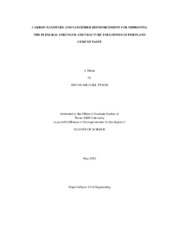| dc.description.abstract | The focus of the proposed research will be on exploring the use of nanotechnology-based nano-filaments, such as carbon nanotubes (CNTs) and nanofibers (CNFs), as reinforcement in improving the mechanical properties of portland cement paste as a construction material. Due to their ultra-high strength and very high aspect ratios, CNTs and CNFs have been used as excellent reinforcements in enhancing the physical and mechanical properties of polymer, metallic, and ceramic composites. Very little attention has been devoted on exploring the use of nano-filaments in the transportation industry. Therefore, this study aims to bridge the gap between nano-filaments and transportation materials. This will be achieved by testing the integration of CNTs and CNFs in ordinary portland cement paste through state-of-the-art techniques. Different mixes in fixed proportions (e.g. water-to-cement ratio, air content, admixtures) along with varying concentrations of CNTs or CNFs will be prepared. Different techniques commonly used for other materials (like polymers) will be used in achieving uniform dispersion of nano-filaments in the cement paste matrix and strong nano-filaments/cement bonding. Small-scale specimens will be prepared for mechanical testing in order to measure the modified mechanical properties as a function of nano-filaments concentration, type, and distribution. With 0.1 percent CNFs, the ultimate strain capacity increased by 142 percent, the flexural strength increased by 79 percent, and the fracture toughness increased by 242 percent. Furthermore, a scanning electron microscope (SEM) is used to discern the difference between crack bridging and fiber pullout. Test results show that the strength, ductility, and fracture toughness can be improved with the addition of low concentrations of either CNTs or CNFs. | en |


